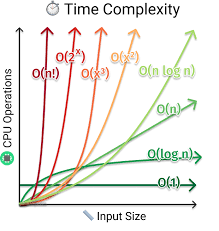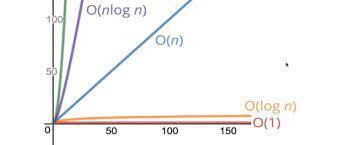In this blog post, we will explore the concept of time and space complexity and its significance in evaluating the performance of data structures and algorithms.
What is Time Complexity?
Time complexity refers to the measure of the amount of time an algorithm takes to complete as a function of the length of its input. It characterizes the efficiency of an algorithm in terms of the number of basic operations performed relative to the size of the input. Time complexity is often expressed using Big O notation, which provides an upper bound on the asymptotic growth rate of the algorithm's runtime.
Let's explore some common time complexities and their descriptions:
O(1) - Constant Time Complexity: An algorithm with constant time complexity executes in the same amount of time regardless of the input size. It means that the algorithm's runtime does not increase as the input size grows.
O(log n) - Logarithmic Time Complexity: Algorithms with logarithmic time complexity exhibit a logarithmic growth rate. As the input size increases, the runtime of these algorithms increases logarithmically.
O(n) - Linear Time Complexity: Linear time complexity means that the algorithm's runtime increases linearly with the size of the input. As the input size grows, the runtime of the algorithm grows proportionally.
O(n log n) - Linearithmic Time Complexity: Algorithms with linearithmic time complexity have a growth rate that is the product of the input size and the logarithm of the input size. Commonly seen in efficient sorting algorithms like Merge Sort and Heap Sort.
O(n^2) - Quadratic Time Complexity: Quadratic time complexity indicates that the algorithm's runtime is proportional to the square of the input size. As the input size increases, the runtime grows quadratically.
Understanding Space Complexity
What is Space Complexity?
Space complexity refers to the amount of memory space required by an algorithm to solve a problem based on the size of the input data. Similar to time complexity, space complexity is often represented using Big O notation. Here are some examples of space complexities along with descriptions and examples:
O(1) - Constant Space Complexity:
Description: The algorithm uses a constant amount of memory space regardless of the size of the input.
Example: Storing a fixed number of variables, such as integers or pointers, regardless of input size.
- O(n) - Linear Space Complexity:
Description: The amount of memory space used by the algorithm grows linearly with the size of the input.
Example: Storing elements of an input array or list where the number of stored elements directly correlates with the input size.
- O(n^2) - Quadratic Space Complexity:
Description: The algorithm's memory usage grows quadratically with the size of the input.
Example: Storing a two-dimensional array or matrix of size n by n, where n represents the input size.
- O(log n) - Logarithmic Space Complexity:
Description: The algorithm's memory usage grows logarithmically with the size of the input.
Example: Recursive algorithms that divide the input size by a constant factor at each recursive step, such as binary search.
- O(n log n) - Linearithmic Space Complexity:
Description: The algorithm's memory usage grows in proportion to n multiplied by the logarithm of n.
Example: Merge sort or heap sort algorithms that require additional space for recursive calls or auxiliary data structures.
Advantages of Analyzing Time and Space Complexity
Analyzing the time and space complexity of data structures and algorithms is crucial for several reasons:
Performance Evaluation: Time and space complexity analysis helps in comparing different algorithms and choosing the most efficient one for a given problem.
Scalability: Understanding the growth rate of algorithms allows us to predict their behavior when dealing with large input sizes.
Optimization: By identifying the bottlenecks in an algorithm, we can optimize it to improve its efficiency and reduce resource consumption.
Resource Planning: Analyzing space complexity helps in estimating the memory requirements for executing an algorithm, allowing for better resource allocation.
Disadvantages of Analyzing Time and Space Complexity
Assumptions about Input Data: Time complexities assume certain properties of input data, such as randomness or uniformity. However, real-world data may not always conform to these assumptions, leading to variations in algorithm performance.
Difficulty in Comparing Complex Algorithms: Comparing the time complexities of complex algorithms, especially those with multiple nested loops or recursive calls, can be challenging. In such cases, analyzing time complexities may require advanced mathematical techniques and may not provide clear insights into which algorithm is more efficient in practice.
Limited Scope: Time complexity analysis primarily focuses on worst-case, average-case, or best-case scenarios. However, these scenarios may not fully capture the behavior of an algorithm across all possible inputs, leading to incomplete evaluations of algorithm efficiency.
Algorithm-Specific Analysis: Time complexities are specific to individual algorithms and may not provide a comprehensive comparison between different algorithmic approaches to solving the same problem. Other factors such as algorithmic simplicity, ease of implementation, and maintainability also influence algorithm selection.
Algorithm Adaptability: Choosing algorithms solely based on time complexity may overlook other important considerations, such as adaptability to changing requirements or compatibility with existing software infrastructure.








Top comments (0)